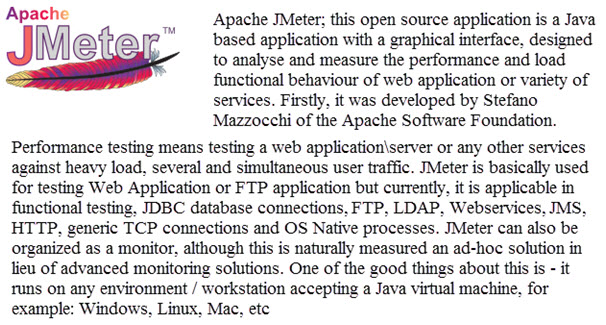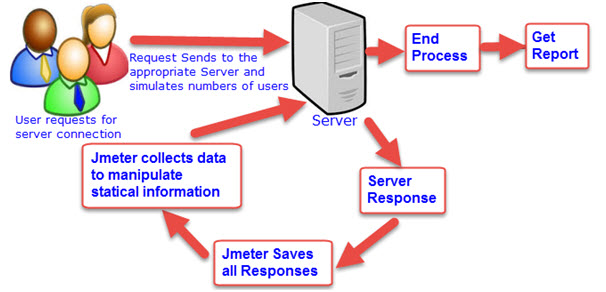Apache JMeter is a great open source application with awesome testing abilities. Web Server is a platform which carries loads of numbers of applications and users, so that it is necessary to know that how does it works or performs means; how effective it is to handle simultaneous users or applications.
For example; how the “Gmail” supporting server will perform when numbers of users simultaneous access the Gmail account – basically have to do performance testing using performance testing tools like JMeter, Loadrunner etc.
To check the high performance of the application or server, do high performance testing using JMeter for exceptional results.
Before understanding Overview of JMeter, let us have a look on three testing approach,
Performance Test: This test provides the best possible performance of the system or application under a given configuration of infrastructure. Very fast, it also highlights the change need to be made before application goes into production.
Load Test: This test is useful for determining and preceding the system under the top load it was aimed to work under.
Stress Test: This test tries to break the system by crushing its resources.
Introduction of JMeter:
JMeter design is based on plugins. Most of its “out of the box” features are applied with plugins. Off-site developers can simply spread JMeter with custom plugins.
JMeter works on these many protocols: Web Services – SOAP / XML-RPC, Web – HTTP, HTTPS sites ‘web 1.0’ web 2.0 (ajax, flex and flex-ws-amf), Database – JDBC drivers, Directory – LDAP, Messaging Oriented service – JMS, Service – POP3, IMAP, SMTP, FTP.
Features Supported by JMeter:
People really think of that why they should go for JMeter? So, to clear their drought, let us get to know JMeter awesome features,
Open source application: JMeter is a free open source application which facilitates users or developers to use source code for other development or modification purpose.
User – friendly GUI: JMeter comes with natural GUI. It is very simple and easy to use and users get familiar very soon with it.
Platform independent: Although, it is totally a Java based desktop application. That’s why; it can run on any platform. It is highly extensible and capable to load the performance test in many different server types: Web – HTTP, HTTPS, SOAP, Database via JDBC, LDAP, JMS, Mail – POP3.
Write your own test: Using plugins, write your own test case to extend the testing process. JMeter uses text editor to create a test plan and supplies in XML format.
Support various testing approach: JMeter supports various testing approach such as Load Testing, Distributed Testing, and Functional Testing, etc.
Simulation: JMeter can simulate various users with simultaneous threads, generate heavy load against web application under test.
Support multi-protocol: JMeter works on web application testing and database server testing, and also supports protocols such as HTTP, JDBC, LDAP, SOAP, JMS, and FTP.
Script Test: JMeter is capable to perform automation testing using Bean Shell &Selenium.
Totally multi-threading framework:. It’s a full multi-threading framework permits simultaneous sampling by many threads and simultaneous sampling of different functions by distinct thread groups.
Easily understandable test result: It visualizes the test result in a format such as chart, table, tree and log file are very simple to understand.
Easy installation step: Just run the“*.bat” file to use JMeter. In Linux/Unix – JMeter can be approached by clicking on JMeter shell script. In Windows – JMeter can be approached by starting the JMeter.bat file.
JMeter architecture working process:
JMeter simulates number of users send request to an appropriate server which shows the performance/functionality of an appropriate server / application via tables, graphs etc. The figure below depicts this process:
Conclusion:
In JMeter training tutorial first article we have seen about introduction of JMeter & what all features supported by JMeter. In next article we will cover “Download & Installation process of JMeter“. If you enjoy reading article then you can subscribe our updates for FREE, just add your email id below:
Don’t Miss Article on JMeter Series
Join over 10,000 people who get FREE and fresh content from this Blog. We Respect Privacy, You’re Safe! No Spam!
FULL LIST OF JMETER TUTORIAL SERIES
Happy Testing!!!
- Elements of JMeter
- JMeter Installation Guide
- Assertions in JMeter – JMeter Tutorials Series Day 7
- How to do Performance Testing using JMeter? – JMeter Tutorials Series Day 5
- Uses of Processor in JMeter – JMeter Tutorials Series Day 9
- Recording using HTTP Proxy Server in JMeter – Performance Testing Tools
- JMeter’s Distributed Testing – JMeter Tutorials Series Day 10
- What is Performance Testing?
- Timers in JMeter – JMeter Tutorials Series Day 6
- Overview Of Performance Testing With VSTS




6 thoughts on “Tutorial 1: Introduction to Apache JMeter”
Thanks for starting Jmeter training series, this much needed for beginners like us.
Really nice one, Thanks
Eagerly waiting for other training series article!!
Thanks for such a wonderful training series, it is very useful for me. Just I am waiting for continuation..
Thanks a lot for this valuable latest post.
Good
superrrrrrrrrrrrrrrrrrrrrrrrrrrrrrrrrrrrrrrrrrrrrrrrrrrrrrrrrrrrrrrrrrrrrrrrrrrrrrrrrrrrrrrrrrrrrrrrrrrrrrrrrrrrrrrrrrrrrrr